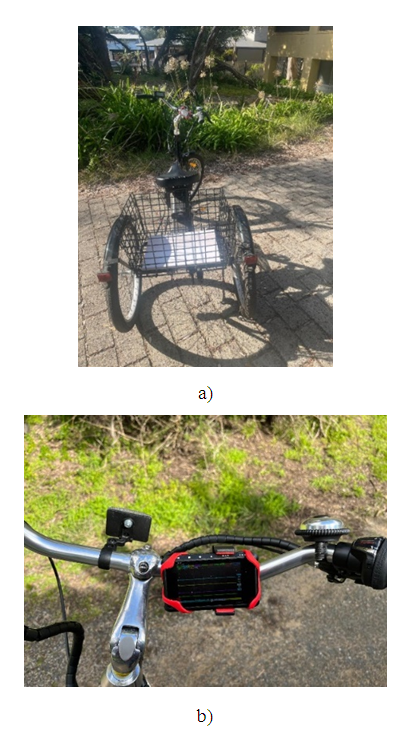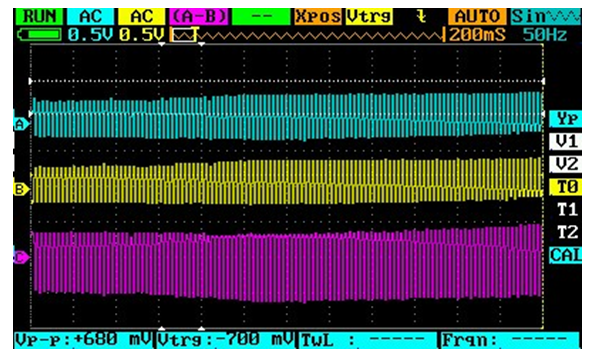-
Paper Information
- Paper Submission
-
Journal Information
- About This Journal
- Editorial Board
- Current Issue
- Archive
- Author Guidelines
- Contact Us
International Journal of Electromagnetics and Applications
p-ISSN: 2168-5037 e-ISSN: 2168-5045
2024; 13(1): 10-13
doi:10.5923/j.ijea.20241301.02
Received: May 30, 2024; Accepted: Jun. 22, 2024; Published: Jun. 24, 2024

Simple and Inexpensive Technology for Recharging of Electric Vehicle while Vehicle is Moving
Irena Cosic, Alexandra Lazar, Drasko Cosic
R&I, AMALNA Consulting, Black Rock, Australia
Correspondence to: Irena Cosic, R&I, AMALNA Consulting, Black Rock, Australia.
| Email: |  |
Copyright © 2024 The Author(s). Published by Scientific & Academic Publishing.
This work is licensed under the Creative Commons Attribution International License (CC BY).
http://creativecommons.org/licenses/by/4.0/

To solve problems with charging of electric vehicles including limited driving range, not enough charging places, long charging times, etc, there is growing interest in technologies that allow electric vehicles to recharge while driving. The innovative technology based on induction from power lines is introduced here. Our previous research on induction of voltage in conductive vires from Earth’s magnetic field only, is extended here with measurements within suburban area, where mostly 50Hz radiation is dominant due to power lines, with the aim to investigate the possibility of recharging electric vehicles’s batteries, while vehicle is moving. The experiments have been done with simplified model of wires and due to fact that induced voltage is proportional to number of wires, the model has been extended with calculations of possible induced voltage for bigger models. It has been found here that the model of reasonable size and number of wires could be used for recharging batteries of electric vehicles through electromagnetic induction, while the vehicle is moving in urban areas with dominant 50Hz radiation. Proposed technology is simple, inexpensive and widely applicable, and it is completely different to already proposed inductive recharging technologies, as it would use already existing power lines networks, rather than requiring building of additional road infrastructure.
Keywords: Electromagnetic induction, Battery recharging, Electric vehicles
Cite this paper: Irena Cosic, Alexandra Lazar, Drasko Cosic, Simple and Inexpensive Technology for Recharging of Electric Vehicle while Vehicle is Moving, International Journal of Electromagnetics and Applications, Vol. 13 No. 1, 2024, pp. 10-13. doi: 10.5923/j.ijea.20241301.02.
1. Introduction
- The modern life is fully dependable on transport, but still mostly based on vehicles running on combustion engines, which due to pollution are quickly becoming outdated. Thus, petrol or diesel vehicles are being quickly replaced by fully electric vehicles (EVs), which have zero tailpipe emissions and are much better for the environment. The main benefit of electric vehicles is pollution reduction, but also electric vehicles produce less noise, are easier to drive and much easier to maintain as electric motors have simpler construction without burning elements.One of the concerns is that electricity being used for running electric vehicles is still mainly produced by fossil fuels. However, this is changing now in favour of renewable energy [1]. On the other hand, the main problem with EVs is limited driving range and charging availabilities. Although driving range is increasing with new models of EVs, it is still a question if there are enough and well-placed charging stations within the driving area. It is an advantage that initial charging can be done at home, but very often there is a need to drive a vehicle far from home and into the rural areas. This is even more relevant for countries like Australia, where distances are large and thus is very costly to have enough charging stations to cover such vast areas. A lack or slow introduction of charging stations has hindered broader use of EVs even the auto industry is moving fast toward electrification. Currently, electric vehicles (EVs) need to stop for recharging at specialised charging stations, and charging process can last from half an hour to several hours, depending on the charging speed and battery size. This charging process represents a huge waste of time for drivers, significantly slowing transport and consequently is increasing costs of transportation. To solve this problem, there is a growing interest in technologies that would allow EVs to recharge while driving. Such technologies could eliminate the need for regular stops at charging points and potentially increase the driving range of EVs. One of the possibilities to recharge electric vehicles while on the move is "dynamic wireless charging" or "inductive charging" technologies, which produce electricity to recharge a vehicle’s battery based on magnetic field induction from a charging infrastructure embedded in the road to a receiver installed in the undercarriage of the vehicle [2]. The wireless technology is currently undertaking research due to their reliable, convenient and efficient charging with minimum human interaction. In review paper [3] the comprehensive literature review is presented including “different types of magnetic coupler designs for both static and dynamic methods and compensation networks, power electronic circuits and architecture, shielding techniques, control systems, standards, and communication networks in stationary and dynamic wireless charging”. However, all these designs require huge infrastructure and coils built-in in the vehicle and thus even more promising, dynamic wireless charging is still in the developmental phase, but would be also very costly for longer distances and thus is not yet widely adopted [2].The first wireless electronic road in USA has been installed in Detroit allowing electric vehicles to charge up as they drive along at the cost of two million dollars per mile [4]. The question: is this really the future of transport?In addition, Sweden has pioneered electrified roads through several pilot projects, including the world's first temporary electric road [5]. Another such example has been made in Japan with wireless EVs recharging while driving with technology similar to wireless smartphone charging. The chargers embedded in the road apply an electrical current only after detecting a vehicle [6].Mentioned above technologies are very expensive and limited to a small number of city roads and can be implemented only for short distances. As such these technologies are not applicable for longer drives nor for rural areas and only very wealthy and small in area countries can afford it. Thus, it would be hugely beneficial to have a technology of recharging EV batteries while driving, which would be simple, inexpensive, and applicable in any area with power lines.Here, the novel technology for continuous recharging of electric vehicles while they are driving has been presented. This technology is simple, inexpensive, and widely applicable. It is completely different to already proposed inductive recharging technologies and will take advantage of power lines that already exist in all urban areas.
2. Methods
- This paper is a continuation of our previous research [7], where induction of voltage, due to the Earth’s magnetic field only, in conductive wires mounted on the roof of the car while vehicle is moving, has been investigated. Within this previous research the following has been shown:1. Electromagnetic field is indeed induced in conductive wires when they are cutting lines of the Earth’s magnetic field. 2. Voltage of this induced electromagnetic field is proportional to the speed of the vehicle.3. This electromagnetic field is proportional to the number of wires used.However, with the Earth’s magnetic field present only, the induced voltage is extremely low, and it would require a large number of wires to produce voltage that can be sufficient for recharging batteries. In addition, it is extremely unusual to drive electric vehicle in areas with only the Earth’s magnetic field present. The most usual situation is to drive electric vehicle within urban areas, where there is a variety of electromagnetic radiation present, mostly from 50Hz power supply, but also from microwave communications, TV, radio, etc. Such radiation is anyway induced in metal elements of electric vehicle, usually producing Eddy’s currents and as such this energy is wasted [7]. It has been proposed here that voltage induction in the wires could be enough for charging batteries in electric vehicles, while the vehicle is moving through area with electromagnetic radiation present. To prove this idea, the measurements within a suburban area, where mostly 50Hz radiation is present due to power lines, has been done. In such an urban setting, much higher voltage induction is expected and thus the experiments with simpler and smaller model of wires are possible. Results from these measurements could be applicable even for electric bicycles that are becoming more prevalent in urban areas. With the previously obtained knowledge [7], that induced voltage is proportional to the number of wires and speed of the vehicle, it would be easy to then extend these measurement results for bigger models and faster driving. For this experiment a simplified model of parallel wires mounted on an electric tricycle has been designed in form of the panel with 120 wires, 40cm long, mounted on the frame of 40x30cm, as presented in Figure 1.
 | Figure 1. Panel with 120 wires, 40cm long, mounted on the frame of 40x30cm |
 | Figure 2. (a) Simplified model of wires mounted on the tricycle with 40cm long wires perpendicular to the movement of the tricycle. (b) DS213 oscilloscope mounted on the handle of the tricycle |
 | Figure 3. Detailed settings on the screen of DS213 oscilloscope |
3. Results and Discussion
- In the experiment explained above the measured induced voltage recorded on the screen of DS213 oscilloscope is presented in Figure 4. The blue line A is the voltage recorded on the one terminal of the model with wires, while the yellow line B is the voltage recorded on the other terminal of the same model. The purple line is the sum of voltage A and inverted voltage B, and as such is the basis for further rectification.
 | Figure 5. Detailed pick-to-pick value |
 .Using this conversion, our example voltage of 8Vac pick-to-pick would become voltage of 5.7Vdc. This induced voltage, after resistance adjustments, would be enough for recharging one cell of different lithium batteries, which would generally need about 3.65Vdc to be recharged. For recharging more cells, more panels are required. This technology could be easily built in within the frame of vehicle, so the number of wires and panels should not be an issue. Have in mind that this example has been calculated for vehicle velocity of 15km/h (as per experimental measurements) and with increased speed the induced voltage would be proportionally higher.
.Using this conversion, our example voltage of 8Vac pick-to-pick would become voltage of 5.7Vdc. This induced voltage, after resistance adjustments, would be enough for recharging one cell of different lithium batteries, which would generally need about 3.65Vdc to be recharged. For recharging more cells, more panels are required. This technology could be easily built in within the frame of vehicle, so the number of wires and panels should not be an issue. Have in mind that this example has been calculated for vehicle velocity of 15km/h (as per experimental measurements) and with increased speed the induced voltage would be proportionally higher.4. Conclusions
- Even with the huge benefit in pollution reduction, the revolution of electric vehicles is still mostly hindered by problems with their battery charging, which includes limited driving range, not enough charging places and long charging times. To solve these problems there is growing interest in technologies that would allow EVs to recharge while driving. The novel, simple, inexpensive, and widely applicable technology based on induction from power lines into wires mounted on vehicle has been presented here. This technology could possibly enable continuous recharging of electric vehicles while they are driving. The concept has been experimentally tested here with the simplified model and results have been projected through calculations to bigger model, which could induce feasible voltage for recharging electric vehicle batteries while vehicle is moving. The proposal here is completely different to already proposed inductive recharging technologies [3-6] and will take advantage of power lines that already exist in all urban areas. This wires-based technology is simple, inexpensive, and widely applicable. It is completely different to already proposed inductive recharging technologies, as it would use already existing power lines networks, rather than requiring building of additional road infrastructure.The final adjustment of this technology needs to be done by electric vehicle industry for different requirements for recharging different electric vehicle batteries.
ACKNOWLEDGEMENTS
- The authors would like to thank Miss Amy Cosic for proofreading this manuscript.
 Abstract
Abstract Reference
Reference Full-Text PDF
Full-Text PDF Full-text HTML
Full-text HTML